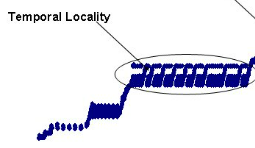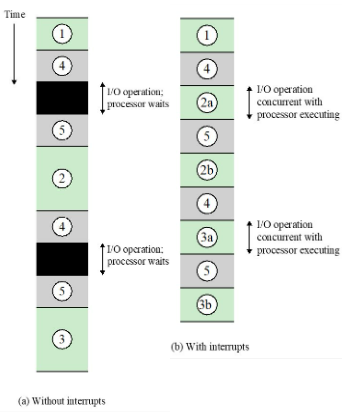OS Midterm
1/115
Earn XP
Name | Mastery | Learn | Test | Matching | Spaced |
|---|
No study sessions yet.
116 Terms
data register
small fast data storage location on the CPU (aka buffer register)
address register
specifies the address in memory for the next read or write
PC (program counter)
holds address of next instruction to be fetched
instruction register
stores the fetched instruction
interrupt
allows other modules to interrupt the normal sequencing of the processor
hit ratio
fraction of all memory accesses found in the cache
Principle of locality
memory references by processor tend to cluster.

temporal locality
limited range of memory addresses requested repeatedly over a period of time

spatial locality
memory addresses that are requested sequentially
cache
small, quick access storage close to the CPU used for repetitively accessed data or instructions. Modernly stored in 3 levels (L1, L2, L3)
memory hierarchy
system of memory levels balancing cost and capacity vs speed. Bigger = slower = cheaper

volatile memory
memory that will be cleared when computer is powered off (ex: RAM)
purpose of interrupts
helpful for handling asynchronous events, multitasking, and error handling
interrupt classes
program (illegal instruction)
timer
I/O
hardware failure
interrupt handler
determines nature of interrupt and performs necessary actions
program flow with and without interrupts
program is able to execute separate instructions when waiting on something (like I/O)

multiple interrupt handling
Approach 1: Disable interrupts while processing an interrupt
Approach 2: Use a priority scheme
calculation of EAT (Effective Access Time)
Ts = H*T1 + (1-H)*(T1 + T2)
where
Ts = average access time
H = hit ratio
T1 = access time of M1 (cache)
T2 = access time of M2 (main memory)
Instruction execution order
fetch instruction, then execute
Operating System
interface between applications and hardware that controls the execution of programs
basic elements of a computer
processor
I/O modules
Main memory
System Bus
system bus
provides communication between computer components
I/O modules
move data between computer and external environment
secondary memory
communication equipment
terminal
programmed I/O
I/O module performs action and sets appropriate bits in I/O status register. processor periodically checks status of I/O module
Interrupt-Driven I/O
I/O module interrupts processor when ready to exchange data
Direct Memory Access (DMA)
performed by separate module on system bus or incorporated into I/O module
symmetric multiprocessors (SMP)
stand-alone computer system where
2+ processors
processors share memory, access to I/O
system controlled by one OS
high performance/scaling/availability
kernel
contains the most frequently used OS instructions and other portions. The central component of the OS. Manages resources, processes, and memory
turnaround time
total time to execute a process
process switch
switching between processes, requires switching data within registers (aka context switch)
process
Instance of a program in execution; unit of activity that can be executed on a processor
3 components of a process
executable program
associated data needed by program
execution context
execution context
internal data OS can supervise/control
contents of registers
process state, priority, I/O wait status
5 OS management responsibilities
process isolation
automatic allocation + management
modular programming support
protection and access control
long-term storage
Application Binary Interface (ABI)
how compiler builds an application. Defines system call interface through user Instruction set architecture (ISA)
Instruction Set Architecture (ISA)
Contains set of executable instructions by CPU. Considered an interface
thread
a lightweight process that shares resources within a process. Dispatchable unit of work; includes a thread context
multithreaded process
process which can separate concurrent threads
multiprogramming
the ability to store processes in memory and switch execution between programs
degree of multiprogramming
number of concurrent processes allowed in main memory
goals of an OS
convenience
efficiency
evolution ability
manage computer resources
multitasking vs parallelism
multitasking executes multiple processes on one CPU by allocating each process CPU time. Parallel processing involves using multiple cores.
activities associated with processes
creation, execution, scheduling, resource management
virtual memory
allocated space for a program that has relative memory addresses
paging
system of fixed size blocks assigned to processes

microkernel architecture
assigns few essential functions to kernel
simple implementation
flexible
good for distributed environment
smaller than monolithic kernels
monolithic kernel
kernel where all components are in 1 address space. large and hard to design, but high performing
signal
mechanism to send message kernel→process
system call
mechanism to send message process→kernel
distributed operating system
provide illusion of
single main and secondary memory space
unified access facilities
object oriented OS
add modular extensions to small kernel
easy OS customizability
eases development of tools
5 process states
new
ready
running
blocked
exiting
blocked vs suspended
Blocked
waiting on event
can run once event happens
Suspended
able to run
instructed not to run
swapping
moving pages from memory to disk
happens when OS runs out of physical memory
dispatcher
small program that switches processor between processes
ready queue
queue that stores processes ready to run (waiting for CPU time)
event queue
queue that manages and processes asynchronous events (ex: timers, I/O)
virtual machine
dedicate 1 or more cores to a particular process and leave processor alone
preemption
suspending a running process to allow another process to run
process switch
7 step execution to switch processes
save processor context
update PCB
move PCB to appropriate queue
select new process
update PCB
update memory data structures
restore processor context
process image
process’s state at a given moment
user-level context
register context
system level context
process control block (PCB)
data needed by OS to control process
identifiers
user-visible registers
control and status register
scheduling
privileges
resources
memory management
role of PCB
contain info about process
read/modified by every module in OS
defines state of OS
hard to protect
User Running (process state)
Executing in user mode
Kernel Running (process state)
Executing in kernel mode
ready to run, in memory (process state)
ready to run as soon as the kernel schedules it
asleep in memory (process state)
unable to run until event occurs; process in main memory (blocked state)
ready to run, swapped (process state)
ready to run, but must be swapped into main memory
sleeping, swapped (process state)
process awaiting event and swapped into secondary storage (blocked state)
preempted (process state)
able to run, but instructed not to. Process returning from kernel mode to user mode, kernel does process switch to switch to other process
created/new (process state)
process newly created; not ready to run. Parent has signaled desire for child but child is not allocated space nor in main memory yet
zombie (process state)
process DNE, but leaves record for parent process to collect
I/O bound processes
processes that spend a significant amount of time waiting for I/O responses
CPU bound processes
processes that spend almost all of their time in CPU time
User vs Kernel mode implementation
user mode requests services from OS through system calls and interrupts
User vs Kernel mode reasoning
protection
security
isolation
flexibility
When Kernel mode is used
applications act in user mode, until they need special access through system calls and interrupts
process creation steps
assign PID
allocate space
initialize PCB
set linkages
create/expand other data structures
Trap
error generated by current process
known as exception/fault
when process switches occur
timeout
I/O
system calls
interrupts
User level thread
thread management done by application
kernel not aware of threads
Kernel level thread
thread management done by kernel
benefits of threads
threads share memory, are quicker, more efficient
5 components of a thread
execution state
thread context
execution stack
storage
memory/resource access
thread execution states
ready
running
blocked
thread operations
spawn
block
unblock
finish
ULT pros and cons
pros:
doesn’t require kernel mode
works on any OS
cons:
system calls block all threads of a process
cannot multiprocess
KLT pros and cons
pros:
can run multiple threads in parallel
can schedule new thread if thread is blocked
cons:
needs kernel mode
OS specific
ULT vs KLT applications
ULT: web servers, games, user level applications
KLT: network services, device drivers, background applications
user vs kernel mode
User: most applications run here, restricted access, safer
Kernel: unrestricted access, dangerous
Amdahl’s law
the idea that speedup has diminishing returns and does not scale linearly. Allows us to determine optimal number of processors
Linux tasks
single-threaded process
thread
kernel tasks
Linux namespaces
separate views that process can have of the system
helps create illusion that processes are the only process on a system
monitor
easier to control semaphore implemented at the PL level
synchronization
enforce mutual exclusion
achieved by condition variables
binary variables that flag suspension or resumption of a process
message passing
needs synchronization and communication
has send and receive
both sender and receiver can be blocked
addressing
schemes for specifying processes in send and receive
direct and indirect
readers/writers problem
data area shared among many processes
3 conditions
any number of readers
1 writer
no reading when writer writing
race condition
when multiple threads/processes read and write data items; final result depends on order of execution
mutual exclusion
requirement that no other processes can be in a critical section when 1 process is accessing critical resources